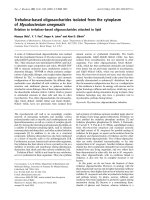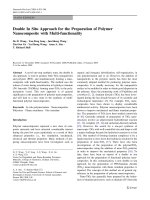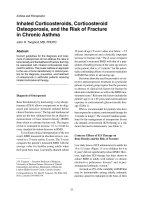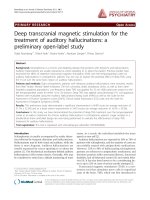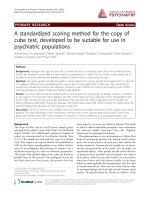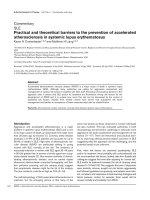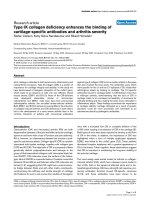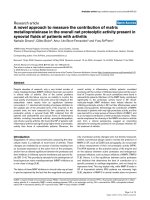Báo cáo y học: "Adherence with urate-lowering therapies for the treatment of gout" pps
Bạn đang xem bản rút gọn của tài liệu. Xem và tải ngay bản đầy đủ của tài liệu tại đây (182.88 KB, 7 trang )
Open Access
Available online />Page 1 of 7
(page number not for citation purposes)
Vol 11 No 2
Research article
Adherence with urate-lowering therapies for the treatment of gout
Leslie R Harrold
1,2,3
, Susan E Andrade
1,2,3
, Becky A Briesacher
1,2
, Marsha A Raebel
3,4
,
Hassan Fouayzi
1
, Robert A Yood
1,5
and Ira S Ockene
2
1
Department of Medicine, the Meyers Primary Care Institute, 425 North Lake Avenue Worcester, MA 01605, USA
2
Department of Medicine, University of Massachusetts Medical School, 377 Plantation Street Worcester, MA 01605, USA
3
The HMO Research Network Center for Education and Research in Therapeutics, Department of Medicine, University of Massachusetts Medical
School, 377 Plantation Street Worcester, MA 01605, USA
4
Department of Research, Kaiser Permanente, Colorado Institute for Health Research, PO Box 378066 Denver, CO 80237-8066, USA
5
Department of Medicine, Fallon Clinic, 425 North Lake Avenue Worcester, MA 01605, USA
Corresponding author: Leslie R Harrold,
Received: 17 Nov 2008 Revisions requested: 7 Jan 2009 Revisions received: 5 Feb 2009 Accepted: 27 Mar 2009 Published: 27 Mar 2009
Arthritis Research & Therapy 2009, 11:R46 (doi:10.1186/ar2659)
This article is online at: />© 2009 Harrold et al.; licensee BioMed Central Ltd.
This is an open access article distributed under the terms of the Creative Commons Attribution License ( />),
which permits unrestricted use, distribution, and reproduction in any medium, provided the original work is properly cited.
Abstract
Introduction Adherence to urate-lowering drugs (ULDs) has not
been well evaluated among those with gout. Our aim was to
assess the level and determinants of non-adherence with ULDs
prescribed for gout.
Methods We identified persons using two integrated delivery
systems aged 18 years or older with a diagnosis of gout who
initiated use of allopurinol, probenecid or sulfinpyrazone from 1
January 2000 to 30 June 2006. Non-adherence was measured
using the medication possession ratio (MPR) over the first year
of therapy and defined as an MPR < 0.8. Descriptive statistics
were calculated and logistic regression was used to estimate
the strength of the association between patient characteristics
and non-adherence.
Results A total of 4,166 gout patients initiated ULDs; 97%
received allopurinol. Median MPR for any ULD use was 0.68
(interquartile range (IQR) 0.64). Over half of the patients (56%)
were non-adherent (MPR < 0.8). In adjusted analyses,
predictors of poor adherence included younger age (odds ratio
(OR) 2.43, 95% confidence interval (CI) 1.86 to 3.18 for ages
<45 and OR 1.44, 95% CI 1.08 to 1.93 for ages 45 to 49),
fewer comorbid conditions (OR 1.46, 95% CI 1.20 to 1.77), no
provider visits for gout prior to urate-lowering drug initiation (OR
1.28, 95% CI 1.05 to 1.55), and use of non-steroidal anti-
inflammatory drugs in the year prior to urate-lowering drug
initiation (OR 1.15, 95% CI 1.00 to 1.31).
Conclusions Non-adherence amongst gout patients initiating
ULDs is exceedingly common, particularly in younger patients
with less comorbidity and no provider visits for gout prior to ULD
initiation. Providers should be aware of the magnitude of non-
adherence with ULDs.
Introduction
Gout is a common inflammatory arthropathy affecting up to 5
million Americans, and yet little is known regarding the dynam-
ics of chronic medication use in these patients [1]. Both recur-
rent and tophaceous gout require sustained treatment with
urate-lowering drugs (ULDs) to reduce the frequency of acute
gouty attacks and prevent urate nephropathy, uric acid neph-
rolithiasis, and the deposition of tophi: a common cause of
progressive joint damage, deformity and functional impairment
[2,3]. Chronic use of ULDs is necessary for lowering and main-
taining serum uric acid levels to a target threshold of <6.0 mg/
dl, as this is associated with fewer gout flares, reduction of
tophus area, and depletion of urate crystal stores in synovial
tissues [4-7].
Surprisingly little is known about how patients with gout man-
age their ULD therapy even though adherence is critical for
preventing the painful and damaging effects of the disease
[8,9]. A recent review of the literature detected very few stud-
ies on this topic [10-13]. In addition, the studies varied in
CERTs: Center for Education and Research on Therapeutics; ICD-9: International Disease Classification; MPR: medication possession ratio; NDC:
national drug codes; NSAID: non-steroidal anti-inflammatory drug; ULDs: urate-lowering drugs; VDW: Virtual Data Warehouse.
Arthritis Research & Therapy Vol 11 No 2 Harrold et al.
Page 2 of 7
(page number not for citation purposes)
terms of study design, study populations, and definitions of
adherence. A recent study comparing medication non-adher-
ence across seven common chronic conditions such as hyper-
tension, osteoporosis and diabetes mellitus found adherence
was lowest with gout [8]. Interestingly, predictors of adher-
ence varied by condition. For example, younger age was asso-
ciated with lower adherence in the treatment of
hypothyroidism and diabetes but not in seizure disorders.
Additionally, as comorbidity burden increased, adherence to
osteoporosis treatment decreased whereas adherence to
medications used to treat hypertension and hypercholestero-
lemia increased.
While non-adherence in certain other chronic conditions (for
example, hyperlipidemia) may not be associated with short-
term consequences, interruptions in ULD use can trigger or
prolong acute gout attacks [3,4]. The most recent publication
looking at predictors of adherence in gout patients was
focused on the elderly (mean age of the study population was
79), and the overwhelming majority of patients were women
[13]. That study population is not representative of patients
typically followed in an outpatient medical practice. Therefore,
more investigation in the rates and causes of non-adherence
in the treatment of gout is necessary, particularly in men and
younger populations. Specifically, the objective of this study
was to analyze the rates and predictors of non-adherence with
ULDs in a representative sample of gout patients. We hypoth-
esized that patients with more frequent gout attacks would be
more adherent.
Materials and methods
Setting and dataset
Two health care delivery systems involved in the Health Main-
tenance Organizations (HMO) Research Network Center for
Education and Research on Therapeutics (CERTs) partici-
pated in this study [14]. The two systems are located in the
Northeast and Rocky Mountain regions of the USA, with a
combined population of approximately 650,000 (2006 fig-
ures). We identified the study cohort using the Virtual Data
Warehouse (VDW), a previously-developed mechanism used
to produce comparable data across participating health plans
[15]. The VDW uses standardized file definitions, uniform data
dictionaries for each content area, and common formats for
each data element. These common file structures enable ana-
lysts at each site to write programs to extract and/or analyze
data at all participating sites. For this study, the analytic data-
set included computerized information on utilization of health
care services including membership, pharmacy dispensing
data, and selected hospital and ambulatory diagnoses and
procedures for all enrollees of the health plans from 1 January
1999 to 30 June 2007. Institutional review boards at each par-
ticipating organization approved this study.
Study population and design
We identified members from the dataset who had an Interna-
tional Disease Classification, version 9 (ICD-9) code for a gout
diagnosis (codes 274.XX), were aged 18 years or older at the
time of the first ULD dispensing, were dispensed a ULD (allop-
urinol, probenecid or sulfinpyrazone) between 1 January 2000
and 30 June 2006 and were continuously enrolled in the
health plan with drug coverage during the period 12 months
prior to and 12 months following the first ULD dispensing. Our
analysis focused on new users of therapy, which was defined
as no dispensing of a ULD in the prior 6 months.
Adherence measure
We used the medication possession ratio (MPR) to measure
adherence [16]. The MPR was calculated as the days supply
of medication dispensed during the follow-up year divided by
the number of days in the year and is a reliable measure of
adherence [17]. The MPR was determined based on phar-
macy dispensing records, including the number of days sup-
plied. Use of the MPR allowed comparisons with other studies
who used similar methods in examining adherence to ULDs
[11-13]. As has been performed in other prior studies, the
MPR was dichotomized at 80% in multivariable analyses, with
an MPR of <80% considered non-adherence [11-13].
Covariates and measures
Patient characteristics were assessed, including those covari-
ates identified as potential correlates of adherence based on
previous studies [11-13,18]. These included demographic
factors (age and sex), health care utilization (visits to providers
for gout both prior to and after ULD initiation, all provider visits
prior to ULD initiation, and number of hospitalizations prior to
ULD initiation), specific comorbidities, other medications used
to treat symptomatic gout, and medications that can trigger
gout. Age (as of first ULD dispensing) and sex were ascer-
tained from the demographic data. We ascertained the pres-
ence of comorbidities from the ICD-9 diagnosis codes
associated with ambulatory, emergency department, and inpa-
tient care during the time period 12 months prior to and 12
months following the first ULD dispensing. Comorbidities of
interest included coronary heart disease, diabetes mellitus,
dyslipidemia, hypertension, nephrolithiasis, peripheral arterial
disease, renal insufficiency and renal failure. A Charlson
comorbidity score (the score does not include a gout diagno-
sis) was ascertained based on a range of diagnoses and pro-
cedures in the 12 months prior to the first ULD dispensing
[19].
Medication usage was identified by determining dispensings
using national drug codes (NDCs) for the following drug
classes: diuretics (thiazide, potassium sparing, loop and oth-
ers), both cyclo-oxygenase selective and non-selective non-
steroidal anti-inflammatory drugs (NSAIDs), colchicine, urico-
suric drugs, xanthine oxidase inhibitors (allopurinol) and gluco-
corticoids. Acute medications for gout were identified based
Available online />Page 3 of 7
(page number not for citation purposes)
on dispensings of NSAIDs, colchicine and glucocorticoids in
the 1 to 12 months prior to the first ULD dispensing. Due to
the recommendations that patients receive prophylactic med-
ications prior to ULD initiation, we looked separately at dis-
pensings of NSAIDs, colchicine and glucocorticoids in the 30
days prior to and including the date of the first ULD dispens-
ing.
Analyses
The characteristics of the study population were examined.
The MPR was examined both by use of specific ULD agents
and by use of any ULDs, so that if patients switched agents,
they could still be considered adherent. Adherence using the
MPR (≥80%) based on initiated ULD (allopurinol vs probene-
cid) was examined using the χ
2
test. We then assessed corre-
lates of non-adherence with use of any ULD. Logistic
regression was used to estimate the strength of the associa-
tion between patient characteristics and non-adherence. Vari-
ables included in the models included age, gender, health care
utilization (number of provider visits for gout, number of pro-
vider visits for any diagnosis and hospitalizations prior to ULD
initiation), Charlson comorbidity score, use of diuretics, use of
acute gout medications in the 1 to 12 months prior to ULD ini-
tiation (NSAIDs, colchicine and glucocorticoids), use of acute
gout medications in the 30 days prior to and including the date
of ULD initiation, and HMO. A backward elimination method
was used to determine the variables to include in the multivar-
iable models, including retaining all variables considered to be
potentially important. Variables with P values < 0.10 remained
in the final models. All analyses were run using SAS version
9.1 (SAS Institute, Cary, NC, USA).
Results
A total of 4,166 patients with a diagnosis of gout who were ini-
tiated on a ULD during the study period. The mean age of the
population was 62 (± 14) years and 75% were male (Table 1).
In the 12 months prior to and including the date of ULD initia-
tion, the mean number of provider visits for gout was 1.67 (±
1.62) with 288 (7%) patients having no in person encounters
during that period. After ULD initiation, the mean number of
provider visits for gout was 1.73 (± 2.43). Comorbidities were
common, including hypertension (70%), dyslipidemia (47%),
coronary heart disease (24%), and diabetes (24%). More than
half of the patients were receiving diuretics.
Table 1
Baseline characteristics of patients initiating urate-lowering therapy
Characteristic Total population (N = 4,166)
Mean age, years (SD) 62 (14)
Gender, N (% male) 3,113 (75)
Number of provider visits for gout prior to ULD initiation, mean (SD)* 1.67 (1.62)
Number of physician visits for any diagnosis prior to ULD initiation, mean (SD)* 6.16 (5.81)
Hospitalization, N (%)* 782 (19)
Number of provider visits for gout after ULD initiation, mean (SD)† 1.73 (2.43)
Charlson comorbidity score, mean (SD) 1.06 (1.64)
Associated comorbidities, N (%):
Hypertension 2,904 (70)
Dyslipidemia 1,976 (47)
Coronary heart disease 1004 (24)
Diabetes mellitus 989 (24)
Renal insufficiency 816 (20)
Renal failure 629 (15)
Peripheral arterial disease 243 (6)
Nephrolithiasis 196 (5)
Medications associated with gout or difficulty treating gout, N (%):
Thiazide diuretics 1,569 (38)
All diuretics 2,259 (54)
*Over the 12 months prior to initiation of a ULD; †over the 12 months after initiation of a ULD.
SD, standard deviation; ULD, urate-lowering drug.
Arthritis Research & Therapy Vol 11 No 2 Harrold et al.
Page 4 of 7
(page number not for citation purposes)
The vast majority of patients initiated treatment with allopurinol
(97%), with 3% receiving probenecid and less than 1% (only
one patient) receiving sulfinpyrazone for urate lowering ther-
apy (Table 2). The median MPR was 0.68 (interquartile range
0.64) for allopurinol and 0.49 (interquartile range 0.70) for
probenecid. Adherence did not differ based on initiated ULD
(allopurinol vs probenecid; P < 0.11) non-adherence (MPR <
0.8) to any ULD during the first year of therapy occurred in
56% of patients (Figure 1).
In the 1 to 12 months prior to ULD initiation, use of acute gout
medications was common (48% of patients were treated with
NSAIDs, 21% colchicine and 18% glucocorticoids). Use of
acute gout medications in the 30 days prior to and including
the date of ULD initiation (potentially dispensings for gout
prophylaxis) occurred in the 64% of patients. NSAIDs and col-
chicine were used in 37% and 29% of patients within the 30
days prior to the date of ULD initiation, respectively. While glu-
cocorticoids are not the typical medications used for gout
prophylaxis, 16% of patients received these agents.
After controlling for health plan, in the adjusted analyses, fac-
tors that increased the probability of non-adherence included
younger age (odds ratio (OR) 2.43, 95% confidence interval
(CI) 1.86 to 3.18 for ages <45 and OR 1.44, 95% CI 1.08 to
1.93 for ages 45 to 49 compared with 75 and older), fewer
comorbid conditions (OR 1.46, 95% CI 1.20 to 1.77 for Charl-
son score of 0 compared with a score of 3 or more), no pro-
vider visits for gout prior to ULD initiation (OR 1.28, 95% CI
1.05 to 1.55 for no visits compared with three or more visits),
and use of NSAIDs in the 1 to 12 months prior to ULD initiation
(OR 1.15, 95% CI 1.00 to 1.31) (Table 3). Those aged 55 to
64 were significantly more likely to be adherent. The number
of physician visits prior to ULD initiation, hospitalizations and
use of prophylactic medications prior to ULD initiation were
not associated with non-adherence. As a sensitivity analysis,
we re-ran the models excluding those with only one prescrip-
tion for a ULD in case those patients were non-adherent due
to an adverse reaction. The strengths of the associations were
essentially the same.
Discussion
In this study, we found poor adherence to newly-initiated ULDs
was common in gout patients, with only 44% of the study pop-
ulation achieving an MPR > 0.80 in the first year of therapy.
Predictors of non-adherence included age less than 50 years,
fewer comorbid conditions based on the Charlson score, no
provider visits specifically for gout care prior to ULD initiation
and the use of NSAIDs in the year prior to ULD initiation. These
findings suggest that younger and healthier patients with gout
may be at particularly high risk for medication non-adherence,
potentially due to a lack of experience in managing other
chronic conditions or seeking care. In addition, these patients
may have a knowledge deficit in how and when to use their
medications. We are currently conducting in-depth patient
interviews to explore these factors.
Our work is consistent with others showing adherence with
ULDs is generally poor, ranging from 44% to 64% of the study
populations [8,11-13]. Previous studies also confirm our find-
ing that younger age is associated with non-adherence
[8,11,13]. Interestingly adherence was best in gout patients in
the middle age groups (ages 55 to 64). This finding has been
Table 2
Use of acute and chronic gout medication treatments in initiators of urate-lowering drugs (ULDs)
ULD Population, N (%)
Allopurinol 4,042 (97)
Probenecid 123 (3)
Sulfinpyrazone 1 (0)
Acute gout treatments prior to ULD initiation*:
NSAIDs 2,003 (48)
Colchicine 862 (21)
Glucocorticoids 742 (18)
Possible gout flare prophylaxis prior to ULD initiation†:
NSAIDs 1,554 (37)
Colchicine 1,189 (29)
Glucocorticoids 675 (16)
Total population N = 4,166.
*Based on dispensings 1 to 12 months prior to ULD initiation; †based on dispensings 30 days prior to and including the date of ULD initiation.
NSAID, non-steroidal anti-inflammatory drug.
Available online />Page 5 of 7
(page number not for citation purposes)
seen in the medication management of other chronic condi-
tions, such as diabetes [20].
This study adds to the body of knowledge regarding non-
adherence in the management in gout. First of all, we evalu-
ated adherence in new users of ULDs and included a sample
of gout patients that reflects the typical outpatient medical
practice. In addition, we evaluated measures of gout care that
have not been previously examined including number of physi-
cian encounters for gout prior to ULD initiation. Lack of pro-
vider visits associated with a gout diagnosis prior to ULD
initiation was associated with non-adherence. This suggests a
face-to-face meeting focused on gout is needed to discuss the
rationale and goals of medication treatment of gout. Interest-
ingly, we found that 7% of our population had no encounters
prior to initiating ULDs. We surmise this occurred when
patients called the physician's office for a prescription before
a visit could occur. Since these patients may not be new users
but rather patients with a long gap since their last prescription,
we conducted a subanalysis excluding those patients from the
model. Non-adherence was still associated with younger age
and fewer comorbid conditions.
Use of NSAIDs, a class of medications used to treat acute
gout, prior to ULD initiation was also significantly associated
with non-adherence and the relationship persisted even when
we controlled for use of prophylactic medications prior to ULD
initiation. This suggests that patients with likely inadequately
controlled gout prior to ULD initiation (reflecting the need for
prescription NSAIDs) are less adherent. This finding was con-
trary to our a priori hypothesis that active gout would be linked
to higher adherence. Interestingly, lack of prophylactic medi-
cations (NSAIDs or colchicine dispensed in the 30 days prior
to and including the date of ULD initiation) was not associated
with non-adherence.
These results have practical implications for clinicians. While
many providers assume patients with painful arthritic condi-
tions are adherent to their medications, our work has shown
that this is not the case. Providers and health care systems
may wish to identify patients at high risk for non-adherence
based on the factors identified in this study. In those high-risk
subsets of the gout population, providers could emphasize the
rationale and benefits of ULDs in the treatment of gout and the
consequences of non-adherence. Of note, post hoc analyses
revealed that fewer number of provider visits for gout following
ULD initiation were also associated with greater non-adher-
ence both in adjusted and non-adjusted analyses. In light of
these data, providers may wish to automatically schedule fol-
low-up encounters after ULD initiation to review clinical status
and to encourage medication adherence.
One of the strengths of this study is the sample inclusion cri-
terion of a diagnosis of gout, which other studies have not fea-
tured. While this does not eliminate misclassification bias, it
does reduce the likelihood that patients were receiving ULDs
for the treatment of asymptomatic hyperuricemia, in which
treatment recommendations and goals may differ from the
standard lifelong treatment of gout with ULDs [4,21]. We also
included data from two health delivery systems in different
geographic regions, which reduced the influence of regional
prescribing practices on our results and increased generaliza-
bility. Additionally, we were able to explore the relationship
between gout-related care, such as provider visits for gout,
use of acute gout medications prior to ULD initiation and use
of potentially prophylactic medications. Lastly, given the study
population had pharmacy benefits and ULDs are relatively
inexpensive, we minimized the likelihood that financial con-
straints influenced adherence.
This study has several limitations. We conducted a retrospec-
tive analysis of pharmacy dispensings to measure adherence.
Therefore, we could not confirm whether patients actually took
the medications that they had filled. In addition, we did not
have access to the patients or the clinical records to ascertain
the reasons for gaps in therapy. We could not determine
whether patients became non-adherent due to adverse reac-
tions, at the suggestion of their provider, or secondary to other
factors. However, it does seem less likely that non-adherence
was due to an adverse reaction since when we re-ran the anal-
yses excluding those who filled only one prescription the
strengths of the associations were essentially the same.
Additionally, due to the limitations of pharmacy dispensing
records we were not able to confirm the indication for NSAIDs
and colchicine dispensed within the 30 days prior to and
including the date of the first ULD dispensing. Patients may
have also obtained over the counter NSAIDs that would not be
captured by this study. However, since all the patients had
pharmacy benefits, there is a financial incentive to obtain a pre-
scription NSAID rather than take numerous over the counter
pills to replicate the prescription dosage.
We did not have access to laboratory results and thus were
unable to assess the impact of ULD adherence on uric acid
Figure 1
The distribution of the medication possession ratio (MPR) for any urate-lowering drug (ULD) useThe distribution of the medication possession ratio (MPR) for any urate-
lowering drug (ULD) use. The distribution of the study population in
terms of MPR for any ULD use was examined.
Arthritis Research & Therapy Vol 11 No 2 Harrold et al.
Page 6 of 7
(page number not for citation purposes)
levels. We also did not have access to the specialty of the ULD
prescriber and thus could not examine whether adherence
was influenced by provider specialty, specifically whether
patients cared for by rheumatologists were more adherent. In
addition, we were unable to determine definitely if visits asso-
ciated with a diagnosis of gout were for acute gout flares ver-
sus routine follow-up appointments. Therefore, we could not
directly determine the relationship between adherence and
the frequency of gout attacks. Lastly, the population was over-
whelming Caucasian, and thus we could not examine whether
patient race and ethnicity influenced adherence.
Conclusions
Non-adherence with ULDs for the treatment of chronic gout
occurred in the majority of the study population. While further
research is needed to assess the clinical and economic con-
sequences of non-adherence, it is likely the patients did not
achieve the recommended reduction in serum urate levels and
thus are at risk for future gout flares, nephrolithiasis and boney
erosions. Providers should be aware of the magnitude of the
problem of non-adherence with ULDs, and counsel patients
on the need for ULD adherence.
Competing interests
The authors declare that they have no competing interests.
Table 3
Adjusted logistic regression model for non-adherence (medication possession ratio (MPR) < 0.80)*
Variable† Adjusted odds ratio (95% confidence interval)
Sociodemographic:
Gender, female 1.03 (0.88 to 1.19)
Age
<45 2.43 (1.86 to 3.18)
45 to 49 1.45 (1.08 to 1.93)
50 to 54 1.09 (0.86 to 1.39)
55 to 59 0.78 (0.61 to 0.99)
60 to 64 0.75 (0.59 to 0.96)
65 to 69 0.84 (0.67 to 1.04)
70 to 74 0.83 (0.67 to 1.02)
75 + 1.00
Health status:
Charlson comorbidity score
0 1.46 (1.20 to 1.77)
1 1.21 (0.98 to 1.51)
2 1.20 (0.94 to 1.53)
3 or more 1.00
Gout care:
Number of provider visits for gout prior to ULD initiation
0 1.28 (1.05 to 1.55)
1 1.09 (0.92 to 1.30)
2 1.00 (0.83 to 1.21)
3 or more 1.00
Use of acute gout meds 1 to 12 months prior to urate-lowering drug initiation
NSAIDs 1.15 (1.00 to 1.31)
*A backward elimination method was used retaining all variables considered to be potentially important. Variables with P values < 0.10 remained
in the final models. The Hosmer-Lemeshow goodness of fit had a P value of 0.70; †model after controlling for health plan.
NSAID, non-steroidal anti-inflammatory drug; ULD, urate-lowering drug.
Available online />Page 7 of 7
(page number not for citation purposes)
Authors' contributions
All authors made substantive intellectual contributions to this
study to qualify as authors. LH was involved in the conception
and design of this project, analysis and interpretation of the
data, and drafting of this article. SA was involved in the design
of this project, data acquisition and analysis, interpretation of
the data, and critiquing of drafts of this article. BB was
involved in the design of this project, analysis and interpreta-
tion of the data, and critiquing of drafts of this article. MR was
involved in data acquisition, interpretation of the data and cri-
tiquing of drafts of this article. HF was involved in the analysis
of data from this study and interpretation and presentation of
results. RY was involved in the interpretation of the data, and
drafting of this article. IO was involved in the conception and
design of this project, analysis and interpretation of the data,
and critiquing of drafts of this article. All authors read and
approved the final manuscript.
Acknowledgements
LRH was supported by Grant Number K23AR053856 from the National
Institute of Arthritis and Musculoskeletal and Skin Diseases. The content
is solely the responsibility of the authors and does not necessarily rep-
resent the official views of the National Institute of Arthritis and Muscu-
loskeletal and Skin Diseases or the National Institutes of Health.
References
1. Kramer HJ, Choi HK, Atkinson K, Stampfer M, Curhan GC: The
association between gout and nephrolithiasis in men: The
Health Professionals' Follow-Up Study. Kidney Int 2003,
64:1022-1026.
2. Rott KT, Agudelo CA: Gout. JAMA 2003, 289:2857-2860.
3. Shoji A, Yamanaka H, Kamatani N: A retrospective study of the
relationship between serum urate level and recurrent attacks
of gouty arthritis: evidence for reduction of recurrent gouty
arthritis with antihyperuricemic therapy. Arthritis Rheum 2004,
51:321-325.
4. Keith MP, Gilliland WR: Updates in the management of gout.
Am J Med 2007, 120:221-224.
5. Mikuls TR, MacLean CH, Olivieri J, Patino F, Allison JJ, Farrar JT,
Bilker WB, Saag KG: Quality of care indicators for gout man-
agement. Arthritis Rheum 2004, 50:937-943.
6. Perez-Ruiz F, Liote F: Lowering serum uric acid levels: what is
the optimal target for improving clinical outcomes in gout?
Arthritis Rheum 2007, 57:1324-1328.
7. Zhang W, Doherty M, Bardin T, Pascual E, Barskova V, Conaghan
P, Gerster J, Jacobs J, Leeb B, Liote F, McCarthy G, Netter P, Nuki
G, Perez-Ruiz F, Pignone A, Pimentao J, Punzi L, Roddy E, Uhlig T,
Zimmermann-Gorska I: EULAR evidence based recommenda-
tions for gout. Part II: management. Report of a task force of
the EULAR Standing Committee for International Clinical
Studies Including Therapeutics (ESCISIT). Ann Rheum Dis
2006, 65:1312-1324.
8. Briesacher BA, Andrade SE, Fouayzi H, Chan KA: Comparison of
drug adherence rates among patients with seven different
medical conditions. Pharmacotherapy 2008, 28:437-443.
9. Harrold LR, Andrade SE: Medication adherence of patients with
selected rheumatic conditions: a systematic review of the lit-
erature. Semin Arthritis Rheum 2009, 38:396-402.
10. de Klerk E, Heijde D van der, Landewe R, Tempel H van der, Urqu-
hart J, Linden S van der: Patient compliance in rheumatoid
arthritis, polymyalgia rheumatica, and gout. J Rheumatol 2003,
30:44-54.
11. Riedel AA, Nelson M, Joseph-Ridge N, Wallace K, MacDonald P,
Becker M: Compliance with allopurinol therapy among man-
aged care enrollees with gout: a retrospective analysis of
administrative claims. J Rheumatol 2004, 31:1575-1581.
12. Sarawate CA, Brewer KK, Yang W, Patel PA, Schumacher HR,
Saag KG, Bakst AW: Gout medication treatment patterns and
adherence to standards of care from a managed care perspec-
tive. Mayo Clin Proc 2006, 81:925-934.
13. Solomon DH, Avorn J, Levin R, Brookhart MA: Uric acid lowering
therapy: prescribing patterns in a large cohort of older adults.
Ann Rheum Dis 2008, 67:609-613.
14. Chan KA, Davis RL, Gunter MJ, Gurwitz JH, Herrinton LJ, Nelson
WW, Raebel MA, Roblin DW, Smith DH, Platt R: The HMO
research network. In Pharmacoepidemiology 4th edition. Edited
by: Strom BL. New York: Wiley; 2007:261-269.
15. Wagner EH, Greene SM, Hart G, Field TS, Fletcher S, Geiger AM,
Herrinton LJ, Hornbrook MC, Johnson CC, Mouchawar J, Rolnick
S, Stevens V, Taplin S, Tolsma D, Vogt T: Building a research
consortium of large health systems: the Cancer Research Net-
work. J Natl Cancer Inst Monogr 2005:3-11.
16. Andrade SE, Kahler KH, Frech F, Chan KA: Methods for evalua-
tion of medication adherence and persistence using auto-
mated databases. Pharmacoepidemiol Drug Saf 2006,
15:565-574.
17. Hess LM, Raebel MA, Conner DA, Malone DC: Measurement of
adherence in pharmacy administrative databases: a proposal
for standard definitions and preferred measures. Ann Pharma-
cother 2006, 40:1280-1288.
18. Harrold LR, Yood RA, Mikuls TR, Andrade SE, Davis J, Fuller J,
Chan KA, Roblin D, Raebel MA, Von Worley A, Platt R, Saag K:
Sex differences in gout epidemiology: evaluation and treat-
ment. Ann Rheum Dis 2006, 65:1368-1372.
19. Charlson ME, Pompei P, Ales KL, MacKenzie CR: A new method
of classifying prognostic comorbidity in longitudinal studies:
development and validation. J Chron Dis 1987, 40:373-383.
20. Lee R, Taira DA: Adherence to oral hypoglycemic agents in
Hawaii. Prev Chronic Dis 2005, 2:A09.
21. Underwood M: Diagnosis and management of gout. BMJ 2006,
332:1315-1319.
